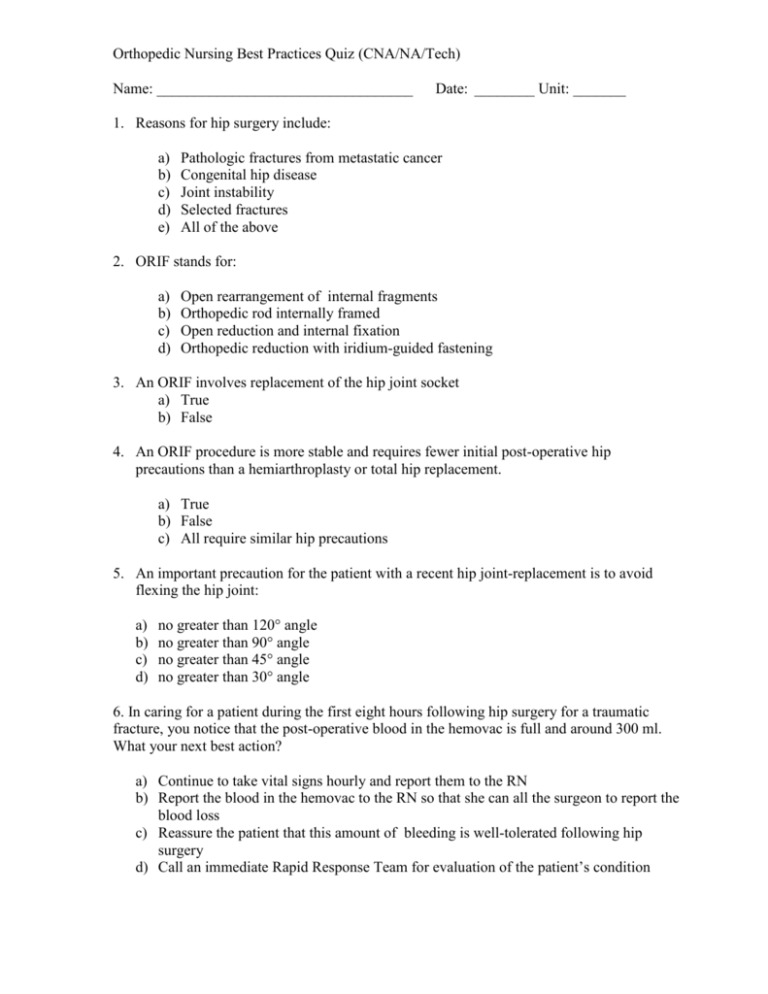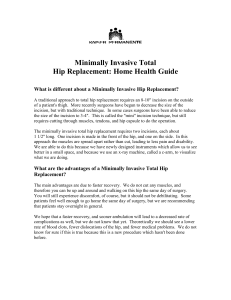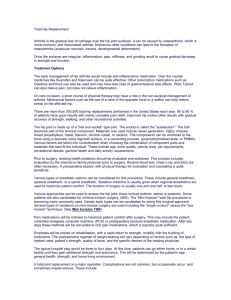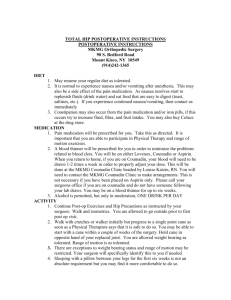Orthopedic NA Tech Quiz - Mad River Community Hospital
advertisement

Orthopedic Nursing Best Practices Quiz (CNA/NA/Tech) Name: __________________________________ Date: ________ Unit: _______ 1. Reasons for hip surgery include: a) b) c) d) e) Pathologic fractures from metastatic cancer Congenital hip disease Joint instability Selected fractures All of the above 2. ORIF stands for: a) b) c) d) Open rearrangement of internal fragments Orthopedic rod internally framed Open reduction and internal fixation Orthopedic reduction with iridium-guided fastening 3. An ORIF involves replacement of the hip joint socket a) True b) False 4. An ORIF procedure is more stable and requires fewer initial post-operative hip precautions than a hemiarthroplasty or total hip replacement. a) True b) False c) All require similar hip precautions 5. An important precaution for the patient with a recent hip joint-replacement is to avoid flexing the hip joint: a) b) c) d) no greater than 120° angle no greater than 90° angle no greater than 45° angle no greater than 30° angle 6. In caring for a patient during the first eight hours following hip surgery for a traumatic fracture, you notice that the post-operative blood in the hemovac is full and around 300 ml. What your next best action? a) Continue to take vital signs hourly and report them to the RN b) Report the blood in the hemovac to the RN so that she can all the surgeon to report the blood loss c) Reassure the patient that this amount of bleeding is well-tolerated following hip surgery d) Call an immediate Rapid Response Team for evaluation of the patient’s condition 7. Which of the following motions by a patient with a right replacement would place them at risk for hip joint dislocation: (Circle all that apply.) a) b) c) d) internal rotation of the right foot and leg crossing the right leg over the left leg crossing the left leg over the right leg early ambulation on the first postoperative day 8. Not all patients recover at the same rate. Not all procedures require the same precautions. Changing the patient’s activity level is based on individual patient’s abilities, procedure guidelines, doctor’s orders and physical therapist’s direction. a) True b) False 9. When the patient is moved in bed immediately postoperatively the assistant correctly and safely turns the patient with a hip joint replacement by which of the following actions? a) Independently turns patient onto the unoperated side while supporting the operated hip securely in an adducted position b) With a second nurse or assistant turns the patient on to the unoperated side while supporting the operated leg and hip in an abducted position c) Leaves the patient on a supine position until the physical therapist is available to help with turning the patient d) With a second nurse or assistant turns the patient on to the operated side while supporting the unoperated leg and hip in an abducted position 10. When assisting the patient with a hip repair on to a fracture pan under what circumstances is it safe to not have an abductor pillow in place? (Circle all that apply.) a) When the patient has had an ORIF b) When the patient with a hip replacement is alert, mobile and able to prevent turning the operated leg inward or flexing the operated hip c) When the patient is uncomfortable with the abductor pillow in place regardless of their degree of alertness d) When the patient is medicated for pain 11. When is a gait belt required for the post-operative hip surgery patient in acute care? a) b) c) d) When first SITTING on the edge of the bed When TRANSFERRING from bed to chair or commode When WALKING the patient on the second post-op day In all of the above situations 12. The proper height of a chair or commode for a patient with a hip replacement or repair is: a) b) c) d) Two inches below the patient’s knee Two inches above the patient’s knee At the level of the patient’s knee At the level of the patient’s hip 13. Which of the following statement is true about “weight-bearing” for the patient with a hip repair or replacement? a) All hip surgery patients are encouraged to weight bear as tolerated on day two b) Permit weight-bearing only as prescribed c) Only patients with hemiarthroplasties are allowed to weight–bear on the second postop day d) Hip surgery patients are no encouraged to weight–bear for up to six weeks. 14. An external fixator maintains the fracture in a stable position and the extremity can be moved during the first 24 hours by: a) Grasping the frame and assist the patient to move the extremity b) Having the patient lift the extremity without assistance c) Teaching crutch walking without weight-bearing when soft tissue swelling has diminished d) Teaching crutch walking with weight-bearing 15. When is it safe for the patient with an EFD (external fixation device) to weight-bare? a) Immediately after the EFD is placed b) Within two weeks after placement of the EFD c) Weight-bearing should occur only after patient is cleared by doctor or physical therapist, and only as prescribed. d) Six to eight weeks after the EFD is placed and bone healing has occurred 16. What is “compartment syndrome”? a) Swelling causing pressure inside of the leg that can cut off circulation to the body part b) Crushing of muscles c) Crushing of bones d) Disruption of nerves 17. Which of the following signs and symptoms is an early indicator of Compartment Syndrome and should be reported to the RN immediately? a) b) c) d) e) Paralysis Numbness or tingling Unrelenting pain Paleness Pulselessness 18. Which of the following situations can lead to compartment syndrome? a) b) b) c) d) e) f) g) h) Blood-soaked padding may shrink beneath a cast and cause constriction of circulation Swelling inside of the muscle casing around any fracture which can constrict blood flow Crush injuries Burns Overly tight bandages Prolonged compression of a limb during a period of unconsciousness Surgery to blood vessels of an arm or leg A blood clot in a blood vessel in an arm or leg All of the above 19. Physical therapy and nursing have over lapping responsibilities in caring for orthopedic patients. The Physical Therapist primary responsibilities in caring for the patient with an ORIF include: a) b) c) d) Monitoring and guiding pain management Assuring safe mobility and teaching use of assistive devices Teaching nutrition for bone healing Preventing skin breakdown 20. I learned at least one piece of information from doing this orthopedic unit and quiz that will improve my personal safety in caring for patients with orthopedic conditions. (Circle one answer and comment on line “C”.) a) True b) False c) _________________________________________________________________







